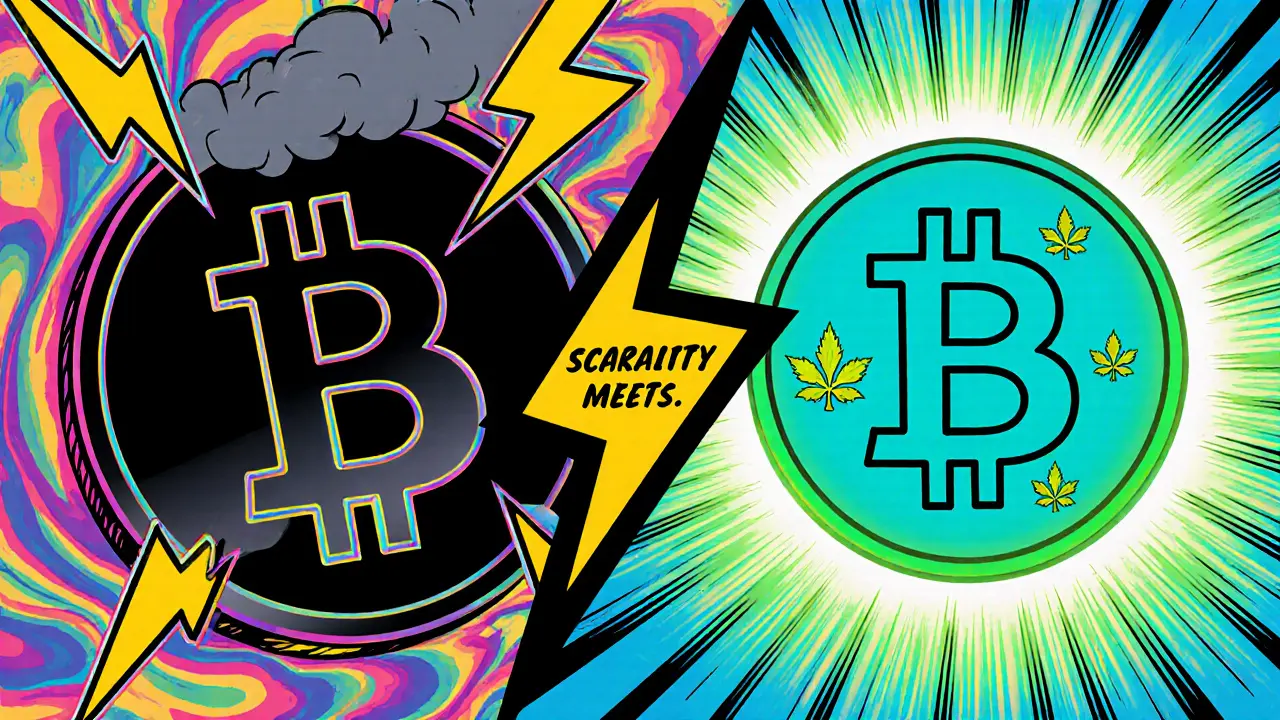Energy Efficiency Calculator
Calculate Energy Savings
Compare the energy consumption of Bitcoin versus Bitcoin.ℏ for your transactions.
Bitcoin uses 703 kWh per transaction
Bitcoin.ℏ uses 0.000003 kWh per transaction
Key insight: Bitcoin.ℏ uses 0 times less energy than Bitcoin.
When you hear "Bitcoin" you probably picture the original proof‑of‑work beast that dominates headlines. Bitcoin.ℏ (also known as BTC.ℏ) is a newer digital asset that tries to keep the scarcity lovers happy while fixing what its creators call Bitcoin’s biggest flaws - energy use, speed, and fees.
What makes Bitcoin.ℏ different?
Bitcoin.ℏ caps its supply at 21 million tokens, the same figure that the original Bitcoin uses. However, only about 2.5 million are in circulation, meaning roughly 12 % of the total supply is on the market today. The token lives on the Hedera Hashgraph network instead of a traditional blockchain. Hedera’s directed‑acyclic‑graph (DAG) design enables energy efficient cryptocurrency operations - roughly 0.000003 kWh per transaction versus Bitcoin’s 703 kWh. The result? Up to 10,000 transactions per second (TPS) can be processed, a stark contrast to Bitcoin’s 7 TPS bottleneck.
Technical backbone
Hedera Hashgraph achieves its speed through an asynchronous Byzantine Fault Tolerance (aBFT) consensus algorithm. Nodes exchange gossip about transactions, then collectively agree on order without mining. This architecture eliminates the need for power‑hungry proof‑of‑work while still offering cryptographic security. One of Hedera’s selling points is quantum‑resistant encryption, which aims to protect the network against future quantum computers.
How Bitcoin.ℏ stacks up against the giants
| Metric | Bitcoin | Bitcoin.ℏ | Ethereum |
|---|---|---|---|
| Consensus | Proof‑of‑Work | aBFT on Hedera Hashgraph | Proof‑of‑Stake (post‑Merge) |
| Max Supply | 21 M BTC | 21 M BTC.ℏ | No fixed cap |
| Current Circulating Supply | ≈ 19 M BTC | ≈ 2.53 M BTC.ℏ | ≈ 122 M ETH |
| TPS (theoretical) | 7 | 10,000 | ≈ 30 (layer‑1) |
| Energy per Tx | ≈ 703 kWh | 0.000003 kWh | ≈ 0.01 kWh (varies) |
| Avg. Transaction Fee | $1-$5 | ≈ $0.0001 | $5-$50 (peak) |
Where to get Bitcoin.ℏ
Unlike Bitcoin, BTC.ℏ isn’t listed on every major exchange. As of October 2025, you’ll usually find it on a handful of platforms such as Phemex (via indirect routes), LBank, and a few decentralized exchanges that operate on Hedera. To move the token, you need a Hedera‑compatible wallet. The two most user‑friendly options are HashPack and Freewallet. Both support HBAR (the native Hedera coin) and allow you to add custom tokens like BTC.ℏ.

Step‑by‑step: Buying and storing BTC.ℏ
- Create a Hedera‑compatible wallet (HashPack or Freewallet). Write down the seed phrase and verify it.
- Buy HBAR on a major exchange (e.g., Binance) and transfer it to your wallet.
- Visit a Hedera‑based DEX (for example, Vibeswap) and swap HBAR for BTC.ℏ.
- Confirm the BTC.ℏ balance appears in your wallet’s token list. If not, add the token contract address manually (available on the project’s GitHub).
- Store the tokens in the wallet’s secure vault or transfer them to a hardware device that supports Hedera (e.g., Ledger Nano X with appropriate firmware).
Pros and cons - a quick checklist
- Pros
- Ultra‑low energy consumption and carbon footprint.
- Lightning‑fast settlement (near‑instant finality).
- Very low transaction fees, ideal for micro‑payments.
- Fixed supply mirrors Bitcoin’s scarcity narrative.
- Cons
- Limited exchange listings → liquidity challenges.
- Smaller node network than Bitcoin, raising questions about decentralization.
- Branding can be confusing; many users think it’s an off‑shoot of Bitcoin rather than a separate token.
- Developer documentation is still thin, making integrations harder.
Real‑world use cases
Early adopters have tested BTC.ℏ for high‑volume retail scenarios. One Reddit user reported processing 500 micro‑transactions for under $0.05 total, thanks to the near‑zero fees. Another experiment involved a gaming platform that used BTC.ℏ to reward players instantly without clogging the network - something Bitcoin’s 7 TPS can’t handle. These pilots suggest the token shines where speed and cost matter more than brand recognition.
Regulatory landscape
Because BTC.ℏ lives on a hashgraph rather than a traditional blockchain, regulators treat it as a “token” rather than a “coin.” The SEC has not issued specific guidance, so projects must still pass the Howey Test for securities. In the EU, the MiCA framework (effective June 2024) places extra scrutiny on assets that claim “utility,” which could affect BTC.ℏ’s marketing claims. Until clearer rulings appear, many exchanges adopt a cautious stance, limiting the token’s visibility.
Future outlook
Analysts are split. Some see BTC.ℏ as a niche player that will grow as eco‑conscious investors demand greener alternatives. Others argue that without broader adoption and stronger decentralization, it will remain a footnote. The token’s market cap sits at roughly $3 million, a drop in the ocean compared with Bitcoin’s $1.2 trillion. Still, its 2025 all‑time high of $3.44 suggests price spikes are possible if liquidity improves and the Hedera ecosystem expands.
Quick FAQ
Is Bitcoin.ℏ the same as Bitcoin?
No. Bitcoin.ℏ (BTC.ℏ) is a separate token that runs on Hedera Hashgraph, while Bitcoin uses its own proof‑of‑work blockchain.
How many Bitcoin.ℏ tokens exist?
The maximum supply is 21 million, mirroring Bitcoin’s cap. About 2.53 million are currently circulating.
What wallet can I use?
HashPack and Freewallet are the most common Hedera‑compatible wallets for storing BTC.ℏ.
Where can I trade Bitcoin.ℏ?
Limited exchanges list it - Phemex (via indirect routes), LBank, and a few Hedera‑based DEXs such as Vibeswap.
Is Bitcoin.ℏ eco‑friendly?
Yes. Its consensus requires about 0.000003 kWh per transaction, dramatically lower than Bitcoin’s 703 kWh.
Whether you’re scouting a greener way to move value or just curious about a new twist on Bitcoin’s scarcity model, Bitcoin.ℏ offers a blend of familiar economics and novel technology. Keep an eye on exchange listings and Hedera’s roadmap - those will be the biggest drivers of real‑world adoption.

Write a comment